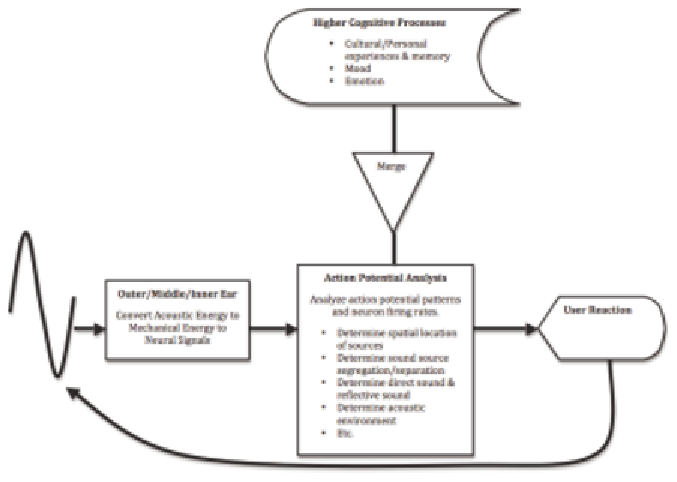Information Technology Reference
In-Depth Information
Figure 1. A simplified outline of the human auditory processing system. Higher cognitive processes
influence what we hear and how we hear the external world
detection and environmental experience (Ashmed
& Wall, 1999).
The physical interaction between moving
sound-waves and static/moving objects in space
are well understood (HRTF, ITD, ILD, Aural Oc-
clusion, Doppler Shift and so on), but the higher
cognitive mechanisms involved in audition have
yet to be fully explored and explained. Many of
these procedures are abstract concepts, such as
the influence of cultural and personal experience
on our sonic perception of space. This aspect of
spatial sound design is vast and scientific meth-
odology has yet to be fully developed for many
of the issues. An understanding of the metamor-
phosis from raw auditory sensation to a spatial
awareness that has meaning is perhaps the final
chapter in creating true spatial sonic interfaces
for VR and computer games. However, from a
commercial standpoint, these issues are for future
consideration given that convincing solutions for
the “simpler” elements of spatial sound (that is,
the physics of sound-wave propagation in the
external environment) remain to be solved
within reasonable cost and performance (Ashmed
& Wall, 1999). Music is perhaps the closest, and
one of the oldest, methods of interacting with
higher cognitive processes. Figure 2 illustrates a
forecast for the evolution of spatial sound imple-
mentation in VR and game technology.
In essence, raw auditory sensation of sound
involves the physical transportation of both the
attributes of the sonic event/source and the prop-
erties of an acoustic space (whether virtual or
real-world) to the listener. Not only does the hu-
man auditory system detect and analyze the
acoustic attributes of the sound source itself and
localize it within a complex sonic soundscape,
but it also determines the acoustic make-up of the
space based on the difference between the direct
sound and the physical effects the space has im-
posed on the sound as it travels through. An un-
finished list of these alterations includes absorp-
tion, reflection, refraction, dispersion, and
occlusion. But raw auditory sensation doesn't end

Search WWH ::

Custom Search